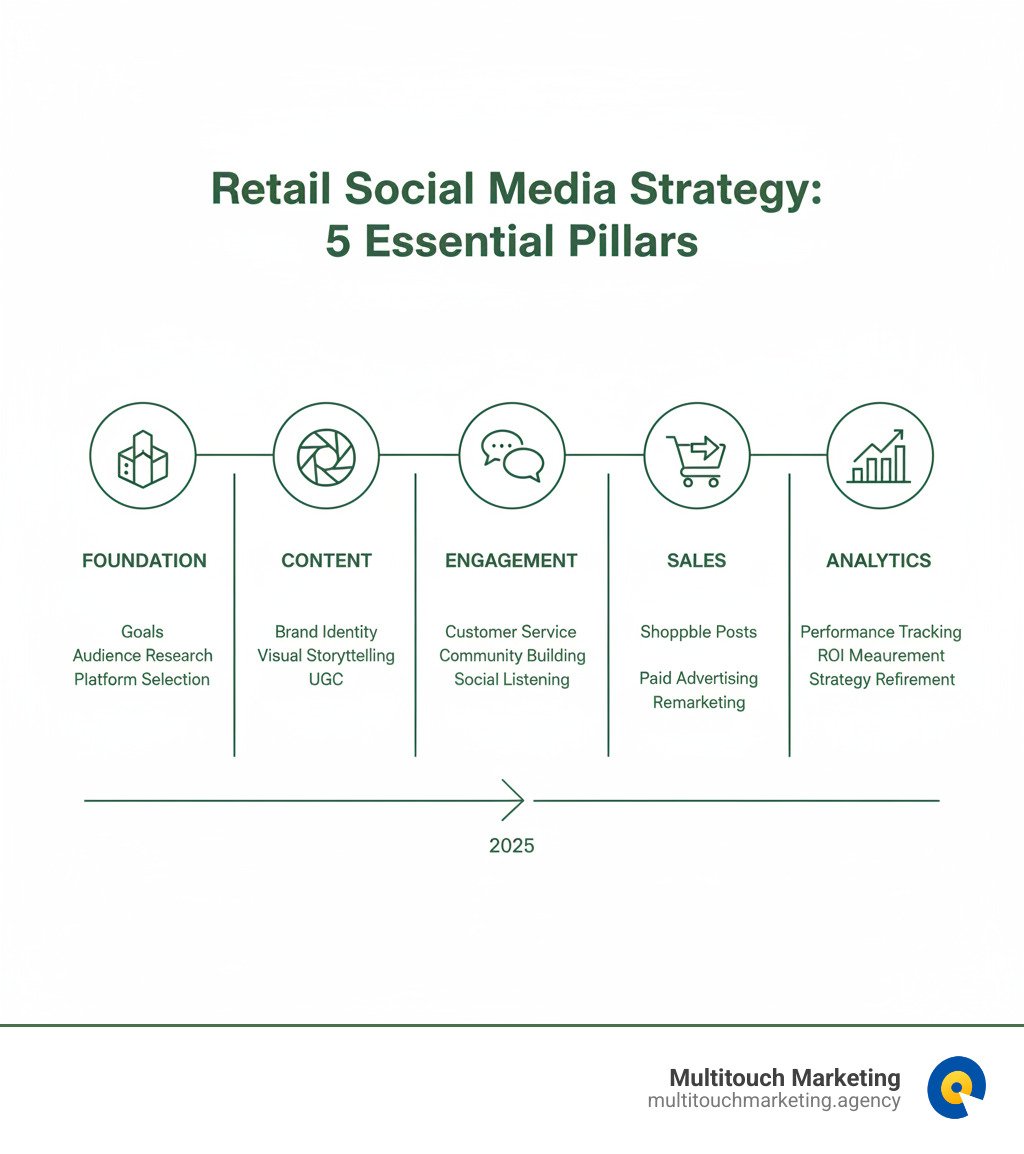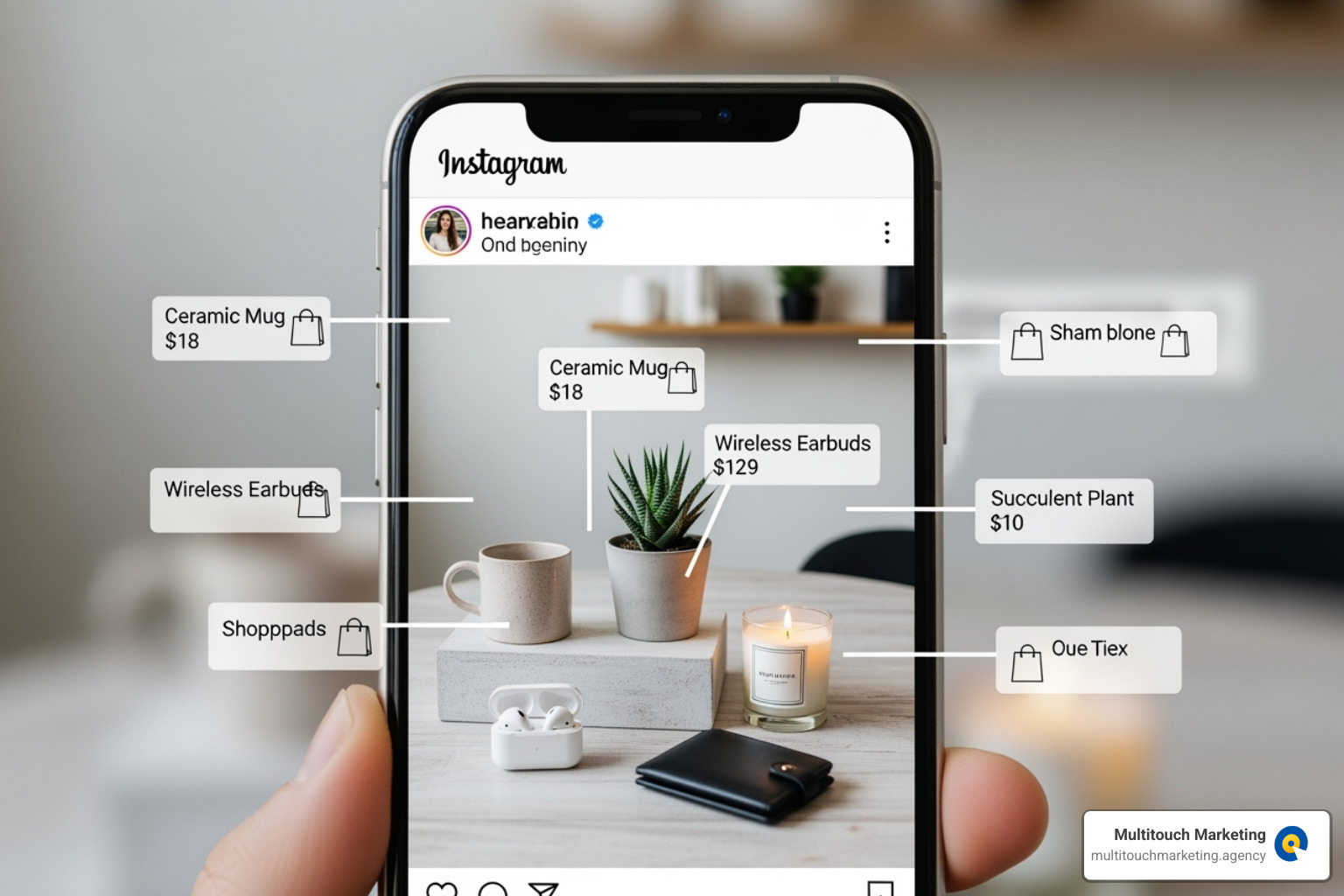Why Retail Social Media Strategy is Your Business Growth Engine
A retail social media strategy is a roadmap for turning social platforms into sales drivers through strategic content, community building, and engagement. Here’s what every retail business needs to know:
Key Components of Retail Social Media Success:
- Goal Setting – Define SMART objectives for brand awareness, traffic, and sales
- Audience Research – Create detailed customer personas based on demographics and behaviors
- Platform Selection – Focus resources where your customers spend time (Instagram for visual products, Facebook for broad reach)
- Content Strategy – Mix product showcases, user-generated content, and behind-the-scenes stories
- Social Selling – Use shoppable posts and targeted ads to drive direct conversions
- Analytics – Track engagement, click-through rates, and ROI to refine your approach
The numbers tell the story: with over 5 billion global social media users, retailers engaging on social media gain 45% more visibility. Facebook and Instagram lead in ROI at 22% and 16%, respectively.
The challenge? 89% of social messages to brands are ignored. This is a massive opportunity, as customers who receive responses are willing to spend up to 20% more with that brand.
Social commerce is here, driving 37% of consumer purchase inspiration in fashion alone. Your social presence directly impacts your bottom line, regardless of your business size.
I’m Milton Brown. With over 15 years of experience scaling businesses with data-driven strategies, I’ve seen that winning brands treat social media as a core revenue channel, not an afterthought. Let’s explore how to build your winning strategy.
Laying the Foundation: Your 5-Step Strategic Blueprint
A successful retail social media strategy needs a solid foundation. Without one, you’re posting without purpose, and your efforts won’t deliver results. A strategic plan ensures every action and ad dollar works toward your business objectives.
Let’s walk through the five essential steps to transform your social media from random posts into a revenue-generating machine. Ready to set a modern social media plan and put it into action? Start here: Set a Social Media Plan. Here’s how.
Step 1: Define Your Goals and KPIs for Your Retail Social Media Strategy
Clear goals are the cornerstone of an effective retail social media strategy. Use SMART goals (Specific, Measurable, Achievable, Relevant, Time-bound). For example, instead of “more followers,” aim to “increase Instagram followers by 25% in three months.”
Key goals include:
- Brand visibility: Expanding your reach and the number of unique users who see your content.
- Lead generation: Driving website traffic, newsletter sign-ups, or direct inquiries.
- Sales and conversions: Tracking direct sales, conversion rates, and average order value from social traffic.
- Customer engagement: Measuring likes, comments, and shares to build a loyal community.
Connect Key Performance Indicators (KPIs) directly to these goals—like follower growth for visibility or conversion rates for sales. Regularly reviewing these metrics tells you what’s working and what needs adjustment. For a deeper dive, see this guide on How to write SMART goals.
Step 2: Understand Your Target Audience and Create Personas
You can’t sell to everyone. A successful retail social media strategy requires knowing your audience. Go beyond demographics to understand psychographics—their motivations, values, and pain points.
Gather insights through surveys, customer interviews, website and social analytics, and customer support interactions. This data reveals who your customers are and what they care about.
Use this research to create detailed customer personas. For example: “Sarah, 28, a marketing professional in Raleigh who values sustainability and finds brands on Instagram Stories.” These personas guide your content, tone, and platform choices, ensuring you reach customers effectively.
Learn more about gathering these insights with Social Media Audience Insights.
Step 3: Conduct a Competitive Analysis and Social Media Audit
A competitive analysis reveals industry trends and opportunities. Identify your main competitors and analyze their social media presence. Look at their content strategy, engagement rates, and visual style. Conduct a SWOT analysis (Strengths, Weaknesses, Opportunities, Threats) to find gaps you can fill.
Simultaneously, audit your own profiles. Review your top-performing content, check for brand consistency in messaging and visuals, and analyze audience activity patterns to optimize your posting schedule and platform priorities.
This dual analysis provides a clear picture of the competitive landscape and your place within it. For Instagram-specific research, explore our guide on Competitive Analysis Instagram.
Step 4: Choose the Right Social Media Platforms for Your Retail Brand
You can’t be everywhere. Focus your retail social media strategy on the platforms where your audience is most active.
- Instagram: Essential for visual products like fashion, beauty, and home goods. With 83% of users finding new products on the platform, its mix of posts, Stories, and Reels is powerful for showcasing items.
- Facebook: Offers the broadest reach and advanced ad targeting. It’s effective for community building and reaching older demographics or selling higher-consideration items.
- TikTok: The hub for younger consumers (Gen Z, millennials) who value authentic, short-form video content. It’s ideal for showing brand personality and participating in trends.
- Pinterest: A visual search engine where users plan purchases. It’s invaluable for fashion, home decor, and lifestyle brands that can provide inspiring, high-quality images.
Data shows Facebook (22%) and Instagram (16%) boast the highest ROI, suggesting where to focus your initial efforts. Also, consider platforms with strong local targeting capabilities, like location tags and geotargeted ads, to reach customers in areas like Raleigh, Durham, or Chapel Hill.
Excel on two platforms rather than being mediocre on five. Master one or two before expanding. For location-based strategies, check out our insights on SMM for Local Businesses.
Content is King: Crafting Your Narrative and Building Community
With the foundation set, let’s focus on content—the heart of your retail social media strategy. Your content is your digital storefront’s personality. It should be inviting and authentic, creating experiences that connect customers to your brand beyond a simple transaction.
Building and Reinforcing a Strong Brand Identity
Your brand identity makes you unique, and social media is where it shines. Consistency is key:
- Brand Voice: Define your tone—are you witty, sophisticated, or friendly? A consistent voice can grow revenue by up to 23%.
- Visual Aesthetics: Use a recognizable color palette, fonts, and photography style so your content is instantly identifiable.
- Storytelling: Go beyond products. Share your brand’s story, behind-the-scenes content, and the lifestyle you enable to create an emotional connection.
- Company Values: Highlight what you stand for, like sustainability or community support. Consumers want to support brands with shared values. This helps you Make Your Business Stand Out with Social Media.
Leveraging Visuals, UGC, and Influencer Marketing
Visuals are essential in retail social media.
- High-Quality Visuals: Use a mix of professional photos, lifestyle shots, and engaging video formats like Reels and Stories. Authenticity often outperforms high polish.
- User-Generated Content (UGC): This is powerful social proof. Since 79% of people say UGC highly impacts their purchasing decisions, encourage it with branded hashtags and contests, and feature customer posts on your feed.
- Influencer Marketing: Partner with micro-influencers and niche influencers whose audiences align with yours. They often have highly engaged communities that trust their recommendations.
- Tools: Use tools like Canva for design and Buffer or Later for scheduling to streamline content creation.
Providing Exceptional Social Customer Service and Engagement
Exceptional social customer service is a massive opportunity. With 60% of people expecting a response within an hour, speed and quality matter. Go beyond generic replies; personalize your interactions to build relationships. Use social listening to monitor brand mentions, spot trends, and gather feedback. Great service creates loyal advocates, while poor service can be costly—58% of consumers would leave a brand after a bad experience.
Integrating In-Store Experiences with Your Social Presence
Bridge the gap between your physical and digital stores.
- Use in-store signage and QR codes to promote your social profiles.
- Add social handles and hashtags to your branded packaging.
- Encourage local check-ins and use community hashtags like #ShopLocal, especially for businesses in Raleigh, Durham, or Chapel Hill.
- Consider Geofence Advertising on Social Media to target nearby customers.
The Social Storefront: Driving Sales and Measuring Your Retail Social Media Strategy
Your retail social media strategy must turn engagement into revenue. Social media is now a 24/7 storefront, with social selling meeting customers where they already are, making the buying process seamless and natural. For businesses looking to maximize their social media impact, our SMM Social Media Marketing services can help create custom solutions that drive measurable results.
Implementing Effective Social Sales Tactics
Use modern social sales tactics to drive conversions directly on the platforms:
- Shoppable Posts and Product Tags: Use features on Instagram and Facebook to tag products in posts, Stories, and Reels, allowing users to buy without leaving the app.
- Limited-Time Offers: Create urgency and encourage immediate purchases with flash sales or scarcity messaging.
- Contests and Giveaways: Boost engagement and introduce your products to new audiences. Accounts hosting contests can grow 70% faster.
- Live Shopping: Host live streams to showcase products, answer questions in real-time, and offer exclusive deals, creating an interactive and urgent buying experience.
To keep these tactics organized, use Social Media Content Calendars to plan promotional content.
Mastering Paid Advertising and Remarketing
Paid advertising is essential for scaling your reach and targeting customers ready to buy.
- Targeted Ads: Use detailed demographic, interest, and behavioral targeting to reach your ideal customers.
- Dynamic Ads: Automatically show users products they’ve previously viewed on your site.
- Custom & Lookalike Audiences: Target your existing customer lists or find new users who are similar to your best customers.
- Remarketing: Re-engage website visitors who didn’t complete a purchase. These campaigns can boost conversion rates by up to 200%.
- A/B Testing: Methodically test one ad element at a time (e.g., image, headline) to optimize performance.
For complex paid campaigns, partnering with experts can maximize your return on ad spend. Check out our Tips for Successful Paid Social Media Campaigns to get started.
Using Analytics to Measure Success and Refine Your Approach
Data is crucial for refining your retail social media strategy.
- Track Performance: Use built-in platform analytics (e.g., Instagram Insights) and Google Analytics to measure traffic and revenue from social channels. Implement conversion tracking with tools like the Facebook Pixel to monitor specific actions.
- Key Retail Metrics: Focus on follower growth, engagement rate, click-through rate (CTR), and conversion rate. Also, track cost per conversion and return on investment (ROI) to measure profitability.
- Refine Your Approach: Regularly review this data to make informed decisions. If videos outperform images, create more videos. If a certain time of day yields more engagement, adjust your schedule. This continuous cycle of measuring and refining separates successful strategies from those that stagnate.
For businesses ready to dive deeper, Advanced Social Media Analytics can provide the insights needed to lift your strategy.
Frequently Asked Questions about Retail Social Media
Here are answers to common questions about retail social media strategy.
Which social media platforms are most effective for retail?
Instagram and Pinterest are best for visual products like fashion, home decor, and beauty. Facebook is versatile, with a broad audience and powerful ad tools. TikTok is ideal for reaching younger demographics with creative, authentic content. The key is to focus on one or two platforms where your target audience is most active rather than spreading yourself too thin.
How much should a retail business budget for social media?
A common starting point is allocating 15% to 25% of your total marketing budget to social media. This should cover:
- Tools: Content creation and scheduling platforms ($50-$200/month).
- Paid Advertising: Start with a modest budget ($200-$500/month) to boost reach and test what works.
- Influencer Collaborations: This can range from product gifting to paid partnerships.
Start small, measure your return on investment (ROI), and scale your budget based on what drives sales.
How can I turn social media followers into paying customers?
Converting followers into customers requires a clear strategy:
- Create a Seamless Path to Purchase: Use shoppable posts and clear calls-to-action (CTAs) in your bio and captions to make buying easy.
- Use Targeted Advertising: Retarget your followers and website visitors, as they are already familiar with your brand and more likely to convert.
- Build Trust: Provide excellent customer service and share authentic content, like user-generated photos.
- Offer Exclusive Deals: Give your social audience special discounts or early access to new products to create urgency and reward loyalty.
Consistency is key, as most customers need multiple touchpoints before making a purchase.
Conclusion
This guide provides a proven roadmap to transform your social media from an afterthought into a revenue engine. The opportunity is clear: while 89% of brand messages are ignored, responsive brands can see customers spend up to 20% more. By following this strategic blueprint—from goal setting and audience research to social selling and analytics—you position your retail business to win.
A solid foundation in strategic planning is crucial. Consistency beats perfection. Start with a solid strategy and commit to refining it based on real customer data.
Data-driven refinement is what builds brand loyalty and drives increased revenue. Your analytics tell you what your customers want; listening and adapting is the key to success.
Social commerce is here to stay. Retailers who master their social presence now will capture the significant growth projected in the coming years.
Ready to take your social media marketing to the next level? Our team at Multitouch Marketing understands the complexities of digital marketing, from PPC campaigns to comprehensive social strategies. Explore our SMM Social Media Marketing services to see how we can help transform your social channels into powerful sales engines.




